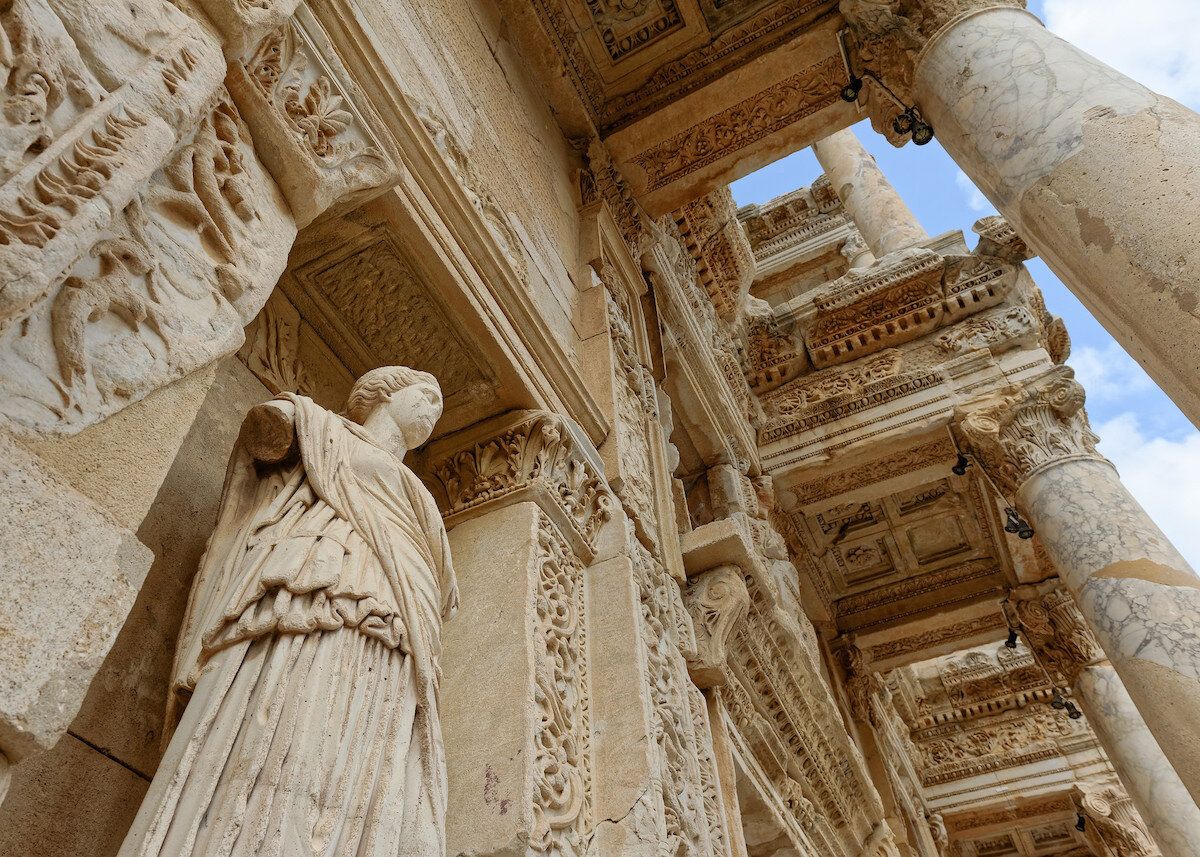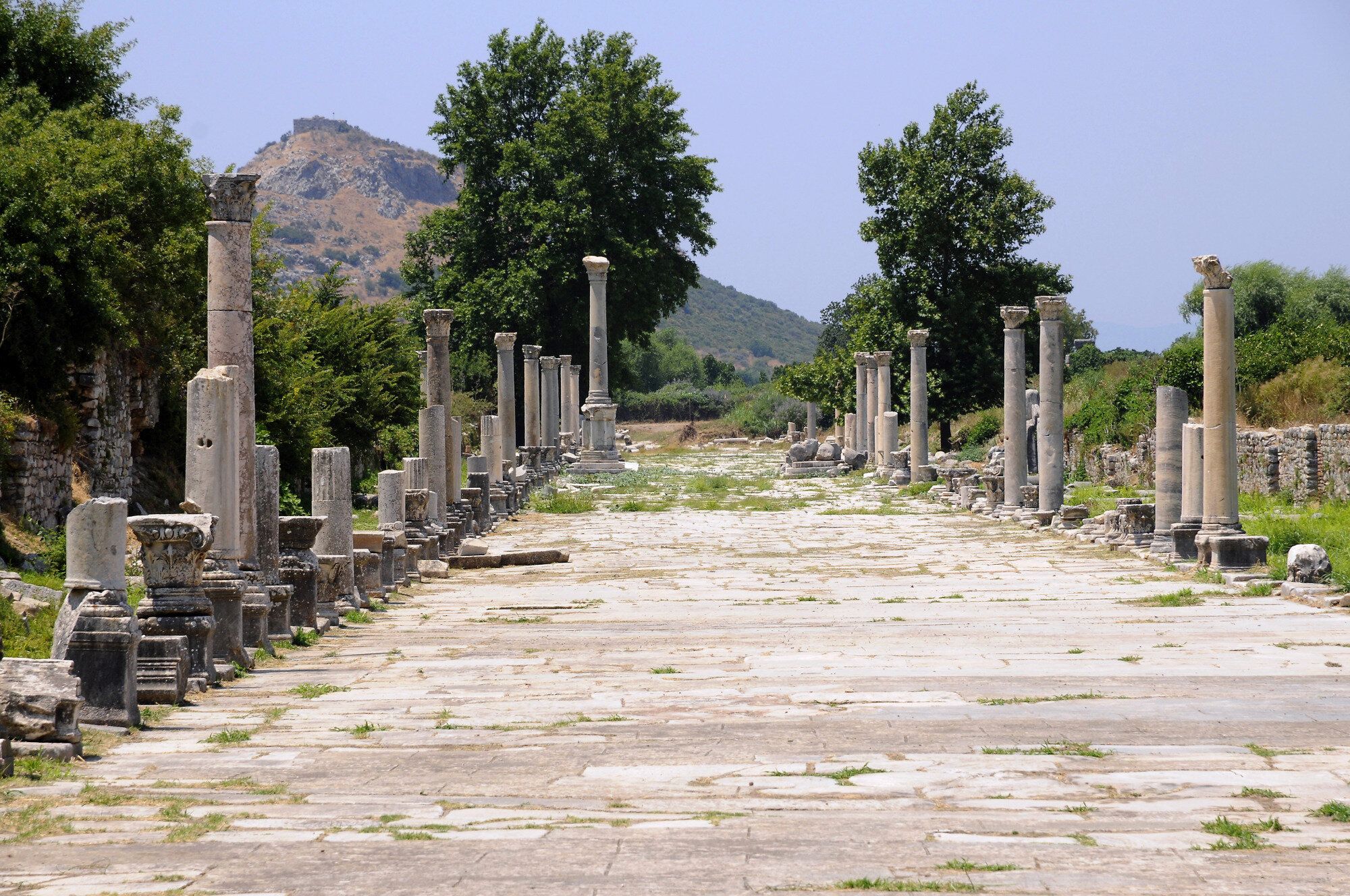
The ancient city of Ephesus (Efes in Turkish) is undoubtedly the most renowned historical attraction in Turkey. Itis situated within the colorful seaside city of Izmir on the west coast of the country. Added to UNESCO’s World Heritage Sites List in 2015, Ephesus hosts thousands of visitors every day from around the world and, in 2019, with approximately 2 million visitors, it was the most visited ancient city in Turkey.
The Artemis Temple, one of the Seven Wonders of the Ancient World, was located in Ephesus. Unfortunately, except for a single column and a few marble blocks, nothing of the temple has survived the years; however, you can imagine how mighty this temple was when you consider the sheer size of the city of Ephesus.
A Brief History of Ephesus
The excavations and research on Ephesus suggest that the area on which its ruins are scattered was inhabited by pre-historic peoples as early as 6000 BC. The first Greek settlers arrived in the area in the 10th century BC. By 560 BC, however, the city had been become centered around the Artemis Temple (which borders the modern-day district of Selçuk in Izmir).
However, the Ephesus which, tourists flock to today, was primarily built in the Hellenistic era by Lysimachus, who was among the most influential generals of Alexander the Great. Ephesus lived its golden age in the Hellenistic and Roman eras, with its population reaching as high up as 200,000. In subsequent centuries, the area was ruled by the Byzantines and later on by the Ottoman Turks.

The Arcadian Street, Photo by Gerhard Huber
Prominence of Ephesus in Christianity
Apart from its Ancient Greek and early Roman history, this heritage site is of vital importance to Christianity.
St. Paul the Apostle, an important Christian figure and one of the Early Christian community leaders, spent 2 years of his life in Ephesus between 52-54 AD. He led the congregation, preached to Ephesus residents about God, and organized missionary trips to areas surrounding the city.
Moreover, it is a common belief that the Virgin Mary may have spent the last years of her life in Ephesus along with St. John the Evangelist. He is said to have written the Gospel here, in which he accounted Jesus instructing him to look after his mother, Mary.
Information About Visiting Ephesus
The ancient city of Ephesus is open every day. Visiting hours are as follows: 8 am - 7.30 pm in the summer period (1 April - 1 October), 8 am – 6 pm in the winter (1 October - 1 April ). The entrance fee is 100 TL (12 USD [October 2020]). The entrance is included in the Museum Pass, which grants you access to Turkey’s major tourist attractions. For more information, see the Muze Kart website.
There is a parking lot for visitors with a fee of 10 TL. Complimentary brochures providing detailed information about Ephesus can be acquired from the kiosk at the entrance.
You can also find booklets detailing Ephesus history in various languages, such as Italian, Korean, Portuguese, and Arabic, at the souvenir shop near the entrance to Ephesus. You can also purchase exciting souvenirs here to take back home! If you prefer audio guides, you can rent one in most languages from the ticket kiosk. After entering Ephesus, you will find plenty of information boards in every nook and corner providing extensive information about the city’s history and architecture, both in English and Turkish.

Library of Celcus, Photo by Mehmet Akinci
What To See in Ephesus?
The Three Main Streets of Ephesus
The Curates, Marble, and Arcadian constitute the three main streets in Ephesus. Walking these streets, abounding with well-preserved historical ruins and erect columns, is a marvelous and photographic experience.
The Curates Street stretches from the Library of Celcus to the Theater of Ephesus. At one point, this street was the high-end of Ephesus, where mostly the upper-classes lived.
The Arcadian Street is the longest one in Ephesus and originates from Theater of Ephesus to the ancient harbor. It was built in the Hellenistic period.
The Marble Road extends from the Hadrian’s Gate (built in honor of Emperor Hadrian’s visit in 124 or 129 AD) to the Library of Celcus. The Marble Road beholds an easter egg that most visitors don’t notice. There is a marble slab embedded in the ground with illustrations of a foot and a few shapes carved into it that have since eroded. On account of its location near the Brothel of Ephesus, this marble slab is assumed to be an advertisement for a sex worker.

Foot carving on the marble slab near Brothel of Ephesus
Library of Celsus
The Library of Celcus symbolizes Ephesus and is indisputably the most notable structure of the ancient city. Along with the Library of Pergamum and the Library of Alexandria, the Library of Celcus is one of the most impressive ones built. With more than 12,000 scrolls, it contributed considerably to the written memory of the ancient world.
In addition, it is considered to be one of the finest examples of ancient Roman architecture. The library was built by Gaius Julius Aquila around 125 AD to commemorate his father, Tiberius Julius Celsus Polemaeanus, who had served as the governor of the Asian Provinces of the Roman Empire. During the library’s construction, Tiberius Julius Celsus Polemaeanus was buried underneath the structure with a sarcophagus that was specially designed for him.
This stunning beauty structure was built with advanced architectural techniques and strategies, one of which was the eastwards direction of the library that allowed it to receive the best light in the daytime.

Library of Celcus, Photo by Haluk Comertel
The Theatre of Ephesus
The Theatre of Ephesus is considered to be one of the largest in the ancient world. With a seating capacity for 24,000 people, the theatre was a hub for the city’s artistic activities. In addition to gladiator fights, many political and public events were also held at the theater. It is also a known fact that St. Paul gave his sermons to the public about God at this very spot.

The Theatre of Ephesus, Photo by Gerhard Huber
The Terrace Houses
Located on the left side of Curates street as you walk to the library, the Terrace Houses (or Slope Houses) are an intriguing remainder of how wealthy people lived in Roman times. The area is covered with a canopy to protect the well-preserved structures from natural elements causing damage over time.
It should be noted that the ticket to Ephesus does not cover the Terrace Houses. If you would like to visit them, you will have to purchase an additional ticket for 45 liras; however, they are certainly worth it.
The earliest of the Terrace Houses was built in the 1st century AD. Prior to the construction of these abodes, the land on which these Terrace Houses were built was used as a burial site during the Hellenistic period.
Astoundingly, these houses, built 2 millenniums ago, had heated floors and walls. This was achieved through an impressive clay pipe system assembled under the floors and inside the walls carrying hot air. These houses were also provided with cold and hot water.
The houses are known for their beautiful mosaic floors, which look almost exactly how they did centuries ago. Wall paintings inside the rooms have vivid colors and have hardly aged.

The Terrace House, Source: archstory.ru
The Odeon
The Odeon is a smaller theater situated on the right side of Marble Road, adjacent to the city’s main entrance. Here, councils, political meetings, and other small-scale events were held. Today, the Odeon of Ephesus often hosts open-air concerts. You can follow the events’ schedules from the website of Biletix, Turkey’s main ticket provider service.
The Scholastic-a Baths
The Scholastic-a Baths Building was the main bathing complex of the city presumed to have been built in the second half of the 1st century A.D. The bath complex was eponymously named after a philanthropist Christian woman named Scholastic-a, who funded its restoration in the 5th century A.D.
Latrines
Ephesus had a functioning public toilet infrastructure that doubled as a place for people to socialize with other locals. This public toilet was built on a running sewage system to avoid the stench.

Hadrian’s Temple, Source: bioedilprogetti.com
Must-see attractions around Ephesus
The House of the Virgin Mary
The House of the Virgin Mary, which now serves as a Catholic shrine, is located on Bülbül Mountain, on which Ephesus was founded on the foothill. It is assumed that St. John the Evangelist brought Virgin Mary to Ephesus after the death of Jesus, based on St. Johns’ writings in the Gospel. From Ephesus entrance, The House of the Virgin Mary is located at a 10-minute up-hill drive.
It is protected by the Municipality of Selçuk, not by the Ministry of Culture and Tourism. Therefore, the Museum Card is not valid here. The entrance fee is 10 liras for Turkish citizens and 25 liras for foreigners.
The story of how this house was discovered up in the tree-covered mountain is interesting. It is claimed that before Ephesus was fully discovered and excavated, a bedridden German nun named Anne Catherine Emmerich had visions about the whereabouts of the House of the Virgin Mary. A French priest, who took the account of Emmerich’s visions, visited Ephesus in 1881 and supposedly found the House of the Virgin Mary standing at the precise location Emmerich had described.
Today, apart from tourists, it is a site for pilgrimage for many staunch Christians. Since the visit of Pope Paul VI in 1967, rituals and ceremonies are carried out at the House of the Virgin Mary each year on the 15th of August.

The House of the Virgin Mary

The Cemetery of Seven Sleepers
This burial complex was built in the 3rd century AD on the eastern foothills of Mount Panayır. As legend suggests, during Emperor Decius reign, 7 Christian men sought refuge in these caves while running away from being prosecuted by the Romans. They believed that they ended up in a miraculous sleep in the cave for over two centuries, only to be woken up during the reign of Emperor Theodosius in the Christian Roman Era and were therefore saved from execution. However, after describing their incredible experience to Emperor Theodosius, they all passed away. The Emperor had them enshrined in a catacomb in the 5th century. Until the Middle Ages, the Cemetery of Seven Sleepers had been a frequent destination for the Christian pilgrims and is an important holy site for Muslims.

The Cemetery of Seven Sleepers
The Artemis Temple
The Artemis Temple, also known as Artemesium, was built in the 6th century BC and is one of the “Seven Wonders of the Ancient World.” It was impressive due to its vast size (about 110 by 55 meters), artisanal artworks, and meticulously carved reliefs. In 356 BC, an arsonist named Herostratus purposely burned down the temple for seeking fame. After the fire, the temple was rebuilt, and a century later, around 260 BC, the temple was decimated by the Goths who had invaded the area.
Unfortunately, not much more than a few marble slabs and a dilapidated column have survived of the temple today.











Member discussion